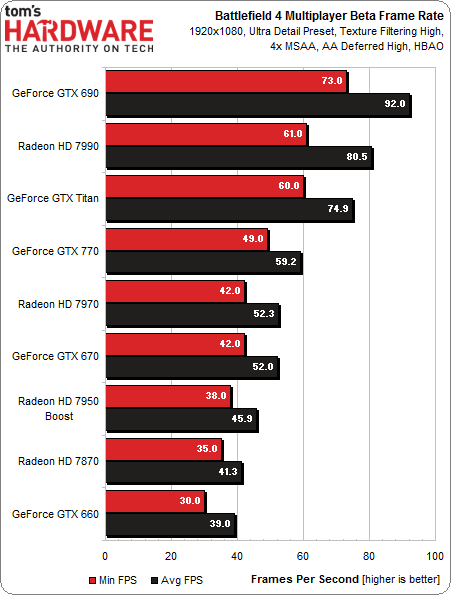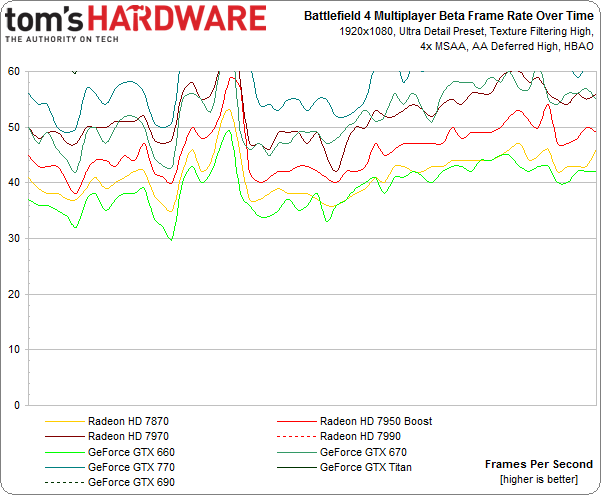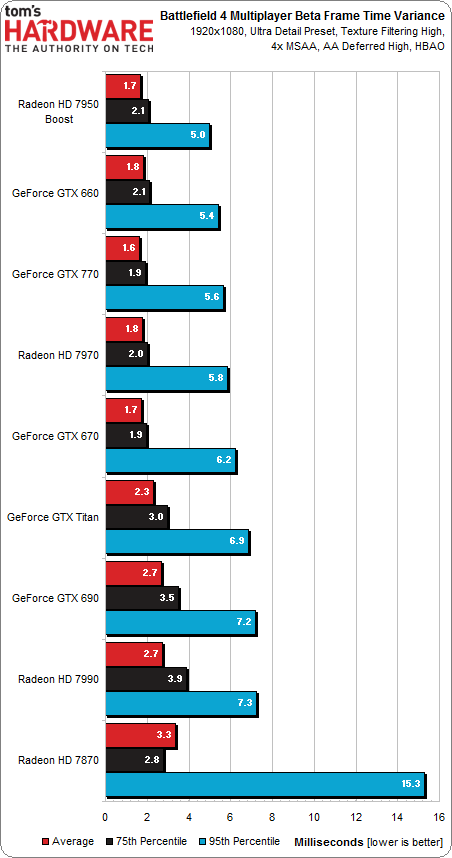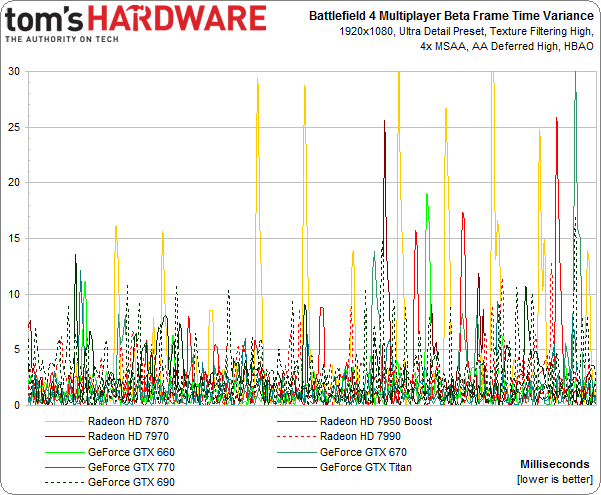Battlefield 4 Beta Performance: 16 Graphics Cards, Benchmarked
We spent our weekend playing the Battlefield 4 multiplayer beta, and made sure to capture a ton of performance data with lots of PC hardware. Does your system have what it takes to handle this title? It comes out this month; you'd better look and see!
Results: Ultra Quality, 1920x1080
Finally, we dial the detail preset up to Ultra for a better idea of how high-end graphics hardware handles Battlefield 4. In addition to bumping up detail, this setting enables 4x MSAA, deferred AA, and HBAO ambient occlusion.
The Ultra setting incurs a significant performance penalty, and while the Radeon HD 7870 and GeForce GTX 660 manage to stay above 30 FPS, their performance is pretty marginal at this preset. We suspect that our frame time variance chart may not be particularly friendly to either card. For now, let's have a look at frame rate over time.
Our contenders land in a pretty tight grouping. The GeForce GTX Titan, 690, and Radeon HD 7990 don't dip below 60 FPS, though again, we'd really like to look at these numbers from an FCAT-based perspective.
Clearly, AMD's Radeon HD 7870 struggles to deliver frames at a consistent pace, and the Radeon HD 7950 Boost has a bit of an issue, too. It's interesting that the Radeon HD 7990 appears to fare better than Nvidia's GeForce GTX 690. We cannot test this theory using FCAT due to the tool's 32-bit limitation, however, the Fraps-based data does appear consistent with our real-world experience. Nvidia's dual-GPU board felt choppier, despite its high frame rate. This could be attributable to its 2 GB of memory per GK104 GPU. But even the GeForce GTX Titan encounters some spikes.
Get Tom's Hardware's best news and in-depth reviews, straight to your inbox.
Current page: Results: Ultra Quality, 1920x1080
Prev Page Results: High Quality, 1920x1080 Next Page Results: Ultra Quality, 2560x1440Don Woligroski was a former senior hardware editor for Tom's Hardware. He has covered a wide range of PC hardware topics, including CPUs, GPUs, system building, and emerging technologies.
-
corvetteguy1994 My system is good to go!Reply
****EDIT BY TOM'S HARDWARE****
Sorry, corvetteguy, you're the first so I'm going to hijack your post to answer some common questions:
- Why didn't you mention mantle?I probably *should* have mentioned it, but at this point it seems a little early. We don't know that much about it and we don't even know exactly when it arrives. Rest assured, when Mantle is rolled out we will cover it!
- Why did you use a Titan in the CPU tests instead of the dual-GPU 690 or 7990?Dual-GPU performance can be tricky, and without FCAT working, I didn't want to report potential pie-in-the-sky FRAPS performance that is difficult to verify. Titan is the fastest single GPU card we have.
- Why no FX-6000 CPU?We benched the FX-4170 and FX-8350. The FX-6000 will be in between, there wasn't a colossal spread so it seems pretty straightforward.
- For the love of everything good and pure, why did you use IE?Haha! Lots of comments on this. I used it because it was there - remember, we clean install for our benchmarks, so unless the test involves browsers we don't bother investing time installing anything else. For the record I feel dirty and violated having opened the software, but you should all know that my personal PC has both Firefox and Chrome installed. :)
Hope that clarifies things!
- Don Woligroski
****END OF EDIT BY TOM'S HARDWARE**** -
itzsnypah Why did you use a Titan for the CPU benchmarks when you have the GTX 690 / HD7990 delivering ~30% more FPS?Reply -
slomo4sho Any particular reason why only the 2500K was overclocked in the CPU benchmarks and why the FX-4170 was benchmarked in place of the 4300 or 6300?Reply -
BigMack70 Would love to see some more detailed CPU benchmarks on a full 64 man conquest server once the game comes out... from some other data out there it looks possible that BF4 multiplayer is the first game to actually benefit from Hyperthreaded i7s over their i5 counterparts.Reply
In 64 man conquest games, doing a FRAPS benchmark of an entire 30 minute round, I got a minimum framerate of 42, average of 74, and max of 118 on my rig (4.8 GHz 2600k || 780 SLI @ 1100/1500 || 16GB DDR3 2133c11) at 1440p with all settings maxed and 120 fov.
Also interesting to see 2GB cards struggling at high res on this game. I really didn't think we'd see that so soon, given that the 780/Titan/7950/7970 are the only cards yet released with >2GB standard memory. -
loops I have an 2500k and an 7870xt (7930). As long as I dont max out AA I tend to be able to play at 45-50 fps with a mix of high/ultra on 1080p/ 24" screen.Reply
But not matter what, each time that main building is blown up I loss at least 5 fps for the rest of the round and have big time fps/lag spikes.
Imo you want an 7970/280x and a quad core to be able to play smooth.
Also, I hear a lot about vram...what is the feed back on 2 gigs vs 3 ? -
smeezekitty I think they focused too much on the bottom end cards (6450, 210). I think anybody that has less than a 6670 probably won't be buying BF4.Reply
I also wish they tested a Radeon and Geforce card that would be considered equal to see how it performs by brand. -
nevilence I have a 7770 and an i5, runs pretty clean on high, wouldnt want to bump up to ultra though, that would likely suckReply -
slomo4sho Reply11689688 said:Weird that there is absolutely no mention of Mantle when BF4 is going to be the first game to implement it.
Considering that mantle wont be available until December, why would it be mentioned? Especially considering the fact that none of the "new" AMD GPUs were included in the benchmarks...



